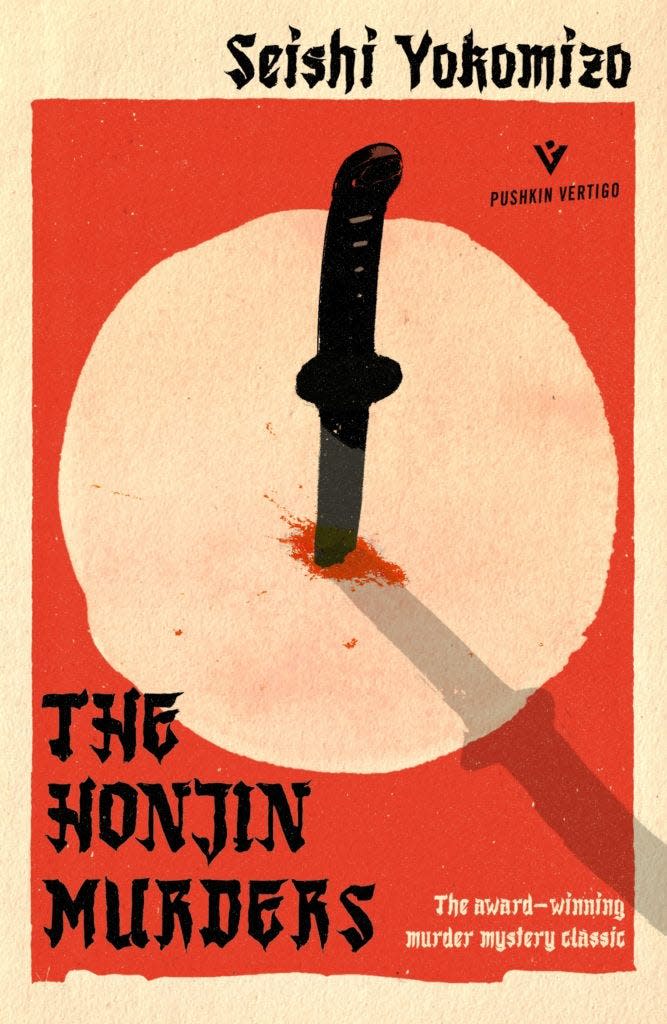Book Look: 'Honjin Murders' takes peek into Japanese culture in compact locked room mystery

- Oops!Something went wrong.Please try again later.
- Oops!Something went wrong.Please try again later.
For the past several years, I have planned to write a column on the "locked room" mystery, using a well-known historical example as my point of reference. Then everything came together when I discovered that the famous Japanese crime writer, Seishi Yokomizo, was being reprinted in the United States.
Using his famous locked room mystery "The Honjin Murders" would also enable me to shed light on Japan's most famous crime writer, Seishi Yokomizo, who wrote dozens of excellent crime novels, several of which are back in publication in the United States.
This crime novel is considered to be the classic Japanese murder mystery. First serialized in 1946 and published in 1973, it was the debut novel of Yokomizo and the winner of the first Mystery Writers of Japan Award.

The novel centers on the well-to-do Ichiyanagi family living in the village of Okamura. The Ichiyanagi family prepares for their eldest son's wedding, Kenzo, to a young woman of humbler origins, Katsuko.
The whole village is shaken when both Kenzo and Katsuko are found slashed to death in their room in the early morning hours after their wedding. Strange and improbable clues make it clear that the murderer could not have escaped the premises after the murder.
The police are baffled, but one local has a connection with a young and unassuming amateur detective named Kosuke Kindaichi, who agrees to come to Okamura and look at the case.
The book also offers an insight into traditional Japan not long after World War II. "The Honjin Murders" is a compact, tightly-woven, brain-teasing crime novel that pays a direct tribute to other crime masterworks.
The biggest plus in the story's development is that the author creates a narrator unconnected to the murders, who tells us about this murder case as he sees it himself; most locked room mysteries are narrated by the person or persons investigating the crime.
Edgar Allan Poe, an early American, invented the detective story and wrote one of the earliest examples of the locked room mystery in his story, "The Murders in the Rue Morgue," published in 1841.
One night at 3 a.m., neighbors hear screams in the apartment occupied by a mother and daughter; they also report hearing two separate voices. The police are called and break into the apartment. Blood is everywhere as well as bags of money from an opened safe. There are no bodies visible. Later the daughter is found dead, stuffed into the chimney, and the mother is found dead in a nearby courtyard. A private detective, C. Auguste Dupin, is brought in to solve the case, which he does.
One of my favorite locked room mysteries was written in 1895 by Jacques Futrelle, a French-American. It is also a short story, albeit a long one.
The protagonist is Professor Augustus S. F. X. Van Dusen, whose nickname is the Thinking Machine. He boasts that no problem is too great for the properly trained human mind.
Two of his friends challenge the professor to put up or shut up. The Thinking Machine is incarcerated in an isolated cell of a high-security prison. He has exactly one week to escape. He succeeds, annoying his guards and even the warden with his bragging predictions.
Author Jacques Futrelle was one of those lost in the Titanic disaster. Interestingly, some of Futrelle's relatives made Sioux Falls their lifetime home.
Another great locked room mystery is "The Mystery of the Yellow Room" by Gaston Leroux, published in 1908. Leroux wrote the famous novel, "The Phantom of the Opera," which is not a locked room mystery. But many readers, myself included, think that "The Mystery of the Yellow Room" is the superior novel.
Two sleuths compete with each other to solve a seemingly unsolvable crime. It matches an amateur detective, Joseph Rouletabille, against France's most famous investigator, Frederic Larson. The only unsolved mystery after the novel is why the story has never been adapted for American audiences in either a full-length movie or miniseries. In France, several films have been based on "The Mystery of the Yellow Room."
One of the most famous locked room mysteries and one of the best is not even a locked room. It is a train. "Murder on the Orient Express" by Agatha Christie, published in 1934.
The Orient Express has been halted by snowfall in the Alps, during which time there is a murder. It also hap during a time when no one could have entered or left the train. The suspects are a motley assortment of passengers, but each new clue uncovered makes it seem less likely that any one of them could have committed the crime. Many impressive movies have been made from this Christie novel.
We circle back to where we started with "The Honjin Murders" by Seishi Yokomizo.
Its main fault may be too many characters for a shorter novel, but the mystery is carefully set with plenty of red herrings and surprises along the way. There are also good opportunities for the reader to solve the case alongside the detective, Kosuke Kindaichi.
"The Honjin Murders," by Seishi Yokomizo, Pushkin Press of London, 2019, first published in Japan in 1973, 189 pages, $14.95.
For September, I will review Clint Smith's book, "How the Word is Passed: A Reckoning with the History of Slavery Across America."
Donus Roberts is a former teacher, current advisor to the ABC Book Club, an avid reader/collector of books, owner of ddrbooks, and he encourages readers to connect at ddrbooks@wat.midco.net.
This article originally appeared on Watertown Public Opinion: Book Look: 'Honjin Murders' brain-teasing, Japanese locked room mystery

